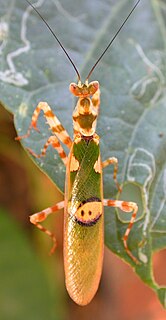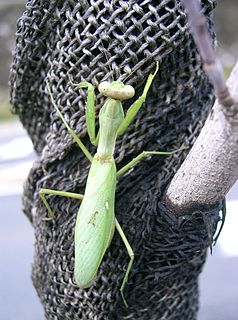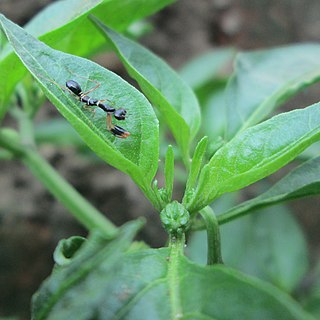
Mantis shrimps, or stomatopods, are carnivorous marine crustaceans of the order Stomatopoda, branching from other members of the class Malacostraca around 340 million years ago. Mantis shrimps typically grow to around 10 cm (3.9 in) in length, while a few can reach up to 38 cm (15 in). The largest mantis shrimp ever caught had a length of 46 cm (18 in); it was caught in the Indian River near Fort Pierce, Florida, in the United States. A mantis shrimp's carapace covers only the rear part of the head and the first four segments of the thorax. Varieties range in color from shades of brown to vivid colors, with more than 450 species of mantis shrimps being known. They are among the most important predators in many shallow, tropical and subtropical marine habitats. However, despite being common, they are poorly understood, as many species spend most of their lives tucked away in burrows and holes.

The Carolina mantis is a species of praying mantis of the subfamily Stagmomantinae.

The Chinese mantis is a species of mantis native to Asia and the nearby islands. In 1896 this species was accidentally introduced by a nurseryperson at Mt. Airy near Philadelphia, United States. Tenodera sinensis often is erroneously referred to as Tenodera aridifolia sinensis because it was at first described as a subspecies of Tenodera aridifolia, but Tenodera sinensis is now established as a full species.

Mantidae is one of the largest families in the order of praying mantises, based on the type species Mantis religiosa; however, most genera are tropical or subtropical. Historically, this was the only family in the order, and many references still use the term "mantid" to refer to any mantis. Technically, however, "mantid" refers only to members of the family Mantidae, and not the 14 remaining families of mantises. Some of the most recent classifications have promoted a number of the mantid subfamilies to the rank of family, e.g. Iridopterygidae, Sibyllidae, Tarachodidae, Thespidae, and Toxoderidae, while other classifications have reduced the number of subfamilies without elevating to higher rank.

Hierodula membranacea is the largest praying mantis, sharing its common name giant Asian mantis with other large members of genus Hierodula: of which it is the type species. Its colours vary from green to yellow-green, or even brown to reddish-brown, similar to those of the giant Indian mantis and the giant Malaysian mantis. As the name suggests, it originates from southeast Asia and is among the largest of mantises. Male and female adults reach around 7–9 centimetres (2.8–3.5 in), excluding extended forelegs. It is a cannibalistic species, with the females sometimes eating the males after mating.

Sibylla pretiosa, commonly known as the cryptic mantis, is a species of mantis found in southern Africa. They have a long and thin prothorax. The distinctively ornamented species has projections on the head, prothorax, and four femora. They live on tree bark in woodlands.

Creobroter is a genus of flower mantises in the tribe Hymenopodini; species are concentrated in Asia. The name comes from the Greek kreo-, meaning "flesh") and broter" meaning "eating", therefore, "flesh-eating", an apt name for a predatory insect. Both sexes have long wings and are capable fliers. Full-grown males are about 3 to 4 cm in length; females are about 4 to 5 cm.

Orthodera ministralis, common name garden mantis or Australian green mantis, is a species of praying mantis from Australia. The garden mantis inhabits the whole of Australia, and can often be found hidden in leafy scrub from ground to eye level. It feeds on small insects by ambushing them.

Sphodromantis viridis is a species of praying mantis that is kept worldwide as a pet. Its common names include African mantis, giant African mantis, and bush mantis.

Hierodula patellifera, common name giant Asian mantis, Asian mantis, Indochina mantis or Harabiro Mantis, is a species of praying mantis belonging to genus Hierodula.

Odontomantis planiceps, also known as Asian ant mantis, is a common species of praying mantis.

Stagmomantis limbata, common name bordered mantis, bosque mantis, Arizona mantis, or New Mexico praying mantis is a species of praying mantis native to North America, most prevalent in the Southwestern United States. This beneficial insect is green or beige in color and grows up to around 3 inches long.
Oxyopsis gracilis, common name South American green mantis, is a species of praying mantis native to South America. It is a medium sized mantis with adult females reaching 3” in length and adult males growing to about 1.5” in length. Individuals of these species are usually bright green.

Sphodromantis is a large genus of praying mantises concentrated in Africa, sometimes considered a synonym of the genus Hierodula: from the same tribe, Paramantini. Outside their range especially, many share the common name African Mantis.

Orthodera novaezealandiae, known as the New Zealand mantis or the New Zealand praying mantis, is a species of praying mantis which is, as both the scientific name and common names suggest, indigenous and endemic to New Zealand.

Theopropus elegans, common name banded flower mantis, is a species of praying mantis native to Southeast Asia.

Oratosquilla oratoria is a species of mantis shrimp found in the Western Pacific. It is widely harvested in Japan where it is known as shako and eaten as sushi. Like other members of its order it has a powerful spear, which it uses to hunt invertebrates and small fish. It grows to a length of 185 millimetres (7.3 in), and lives at depths of 10–100 metres (33–328 ft).

Pseudocreobotra wahlbergii, or the spiny flower mantis, is a small flower mantis native to southern and eastern Africa.

Mantises are an order (Mantodea) of insects that contains over 2,400 species in about 430 genera in 30 families. The largest family is the Mantidae ("mantids"). Mantises are distributed worldwide in temperate and tropical habitats. They have triangular heads with bulging eyes supported on flexible necks. Their elongated bodies may or may not have wings, but all Mantodea have forelegs that are greatly enlarged and adapted for catching and gripping prey; their upright posture, while remaining stationary with forearms folded, has led to the common name praying mantis.

















